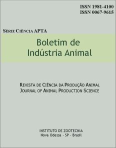Effect of priming witht fsh or fsh-lh in the beginning of oestrus cycle on the ovarian response of superovulated cows
Keywords:
Bovine, embryo, priming, superovulationAbstract
This trial evaluated the effect of priming with FSH or FSH partially purified on the subsequent ovarian response of cows superovulated in the middle of cycle. Sixty cows of the Mantiqueira breed were randomly divided in three groups of 20 animals each. On day 3 and 4 of the estral cycle, groups 1 and 2 received 2.5 mg of FSH-pure and 50 UI de FSH (ratio FSH:LH = 1:1), respectively, while the group 3 (control) received 0,9% NaCl. All cows were superovulated on day 9 to 12 of the estral cycle using 500 UI of FSH-LH administered in decreasing doses, twice a day, during four days. A luteolitic dose of cloprostenol was injected in the morning of the third day of superovulation and the cows were matting with bulls of good fertility approximately 48 hours latter. The ovarian response was evaluated 6 to 8 days after matting by direct counting of follicles and corpora lutea (CL) on the ovary and by embryo recovery from uterine horns after slaughtering the cows. There was no significant difference in the mean number of CL (13.00+ 1.32; 13.69 + 1.25; 12.75 + 1.32, groups 1, 2 e 3, respectively) or embryos recovered (7,96 + 0,68; 9,56 + 0,67; 7,77 + 0,68 groups 1, 2 e 3, respectively). There was a significant increase (P < 0,05) in the mean number of transferable embryos of group 2 (7.53 + 0.49) compared to control (5.30 + 0.50), but not to group 1 (6.23 + 0.50) while the group 1 was not different from the control These results showed that the priming with FSH pure or partially contaminated with LH do not increase the quantity of recovered embryos from superovulated cows.
Downloads
Downloads
Published
Issue
Section
License
Os autores não serão remunerados pela publicação de trabalhos, pois devem abrir mão de seus direitos autorais em favor deste periódico. Por outro lado, os autores ficam autorizados a publicar seus artigos, simultaneamente, em repositórios da instituição de sua origem, desde que citada a fonte da publicação original seja Boletim de Indústria Animal. A revista se reserva o direito de efetuar, nos originais, alterações de ordem normativa, ortográfica e gramatical, com vistas a manter o padrão culto da língua e a credibilidade do veículo. Respeitará, no entanto, o estilo de escrever dos autores. Alterações, correções ou sugestões de ordem conceitual serão encaminhadas aos autores, quando necessário. Nesses casos, os artigos, depois de adequados, deverão ser submetidos a nova apreciação. As opiniões emitidas pelos autores dos artigos são de sua exclusiva responsabilidade. Todo o conteúdo deste periódico, exceto onde está identificado, está licenciado sob a Licença Creative Commons Attribution (CC-BY-NC). A condição BY implica que os licenciados podem copiar, distribuir, exibir e executar a obra e fazer trabalhos derivados com base em que só se dão o autor ou licenciante os créditos na forma especificada por estes. A cláusula NC significa que os licenciados podem copiar, distribuir, exibir e executar a obra e fazer trabalhos derivados com base apenas para fins não comerciais.













